Everyone talks about as if it was the most important thing to consider when attempting to work DX stations or local stations and as if it was a cast in stone property of antennas that any deviation from the specs will surely mean poor contacts. I have been saying for years to forget about trying to optimize your TOA and simply get your antenna up as high as you can and don't worry about what height is the best for working into a specific area of the world. I found this article on Eham written by Tom Rauch, W8JI, that sums things up nicely.
The Myth of Takeoff Angle
from Tom Rauch - W8JI on April 26, 2010
Website: www.w8ji.com
View comments about this article!
The Myth of Takeoff Angle
Antenna discussions and articles often emphasize take off angle. We commonly read or hear that a low takeoff angle is good for DX, and that a high takeoff angle is good for local or short-range work. This is exactly what a good friend of mine, the author of one of the most popular antenna modeling programs, often showed angst over. He often expressed great reservation in including TOA in his software, but felt he had to include take off angle because people expected it. In fact, if we go to the help menu in most versions of his software and search for instructions on using TOA (or takeoff angle), help is not there!
So what is takeoff angle? How can we use it? Is it useful for anything? My answer to that, surprisingly to the great believers in TOA, is TOA is not worth anything by itself. Let us look at some examples, and see how little value TOA really has.
Vertical vs. Dipole
We all know a vertical antenna is great for DX because it has a "low takeoff angle", and a modest height dipole is better for modest distances because it has a "high takeoff angle". Let us see how true this is.
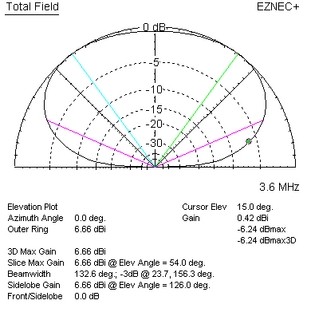
Figure 1: Dipole at 1/3 wavelength
This dipole is 1/3 wavelength high (figure 1). The peak gain is 6.66 dBi, and it has a takeoff angle of 54 degrees. At 15 degrees, dipole field intensity is .42 dBi. Few who focus on takeoff angle would consider this antenna "DX worthy", or even think it would make DX contacts.
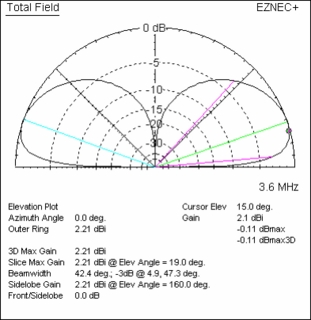
Figure 2: Vertical with 16 radials
We see now that a vertical with 16 radials (figure 2) has peak gain at 19 degrees, where gain is 2.21 dBi. Gain at 15 degrees, an angle considered very useful for long haul DX on lower HF bands, is 2.1 dBi. This vertical has only 1.7 dB more signal level than the useless cloud warmer dipole at the very useful low band DX angle of 15 degrees! At 19 degrees, the peak radiation angle of the vertical, the dipole and vertical are essentially equal in field strength even though the vertical has a TOA of 19 degrees and the dipole has a TOA of 54 degrees.
This does not mean the vertical is useless for closer contacts, but it certainly is at a huge disadvantage compared to the dipole. It also does not mean the dipole will not work DX, or will not at times be stronger than the vertical over very long distances. Small differences in location, propagation, and installation could easily make the dipole the better antenna for long distances. The only sure bet is the vertical will not be good for very high angle propagation.
Obviously, TOA by itself tells us little about an antenna's ability to be a good DX antenna. What then is important? With what should we really be concerned?
The answer is almost painfully logical; we want maximum available field strength over the entire useful range of angles and directions. Peaks and nulls outside of the desired range of angles and directions are of no concern when our goal is developing the maximum most consistent signal into a specific desired location. We should not care about or even bother discussing TOA; we only want maximum field strength in our target area!
Nulls, a Major Problem We Ignore
We know we want maximum signal over the useful and most desired angles and directions of radiation, but we should never confuse that with maximum peak gain in that area. Peak gain, by itself, is as useless and meaningless as TOA. Let's look at a few examples of high useless gain.
Let's assume we are in the center of the USA, and we want to work most of the USA with our multiband antenna. We all know a low band loop, operated up near the high end of HF, has considerable gain. That is a good thing, isn't it? After all, everyone wants a high gain antenna.
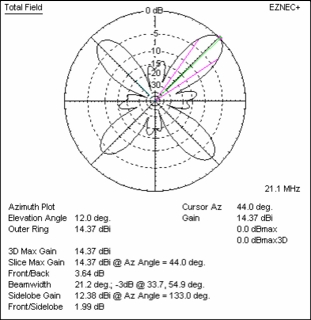
Figure 3: 80-meter loop on 15-meter band
Our eighty-meter full wave loop antenna (figure 3) has 14.37 dBi gain, about 6 dB more gain than a dipole, when used on fifteen meters. While this may sound attractive, this 6 dBd of additional field strength divides between four major lobes and four minor lobes. The average gain in the main lobes is 12.46 dBi or about 4 dB over a dipole. Worse yet, that gain is in an azimuth beamwidth of only 21 degrees for each of the lobes, and next to those peaks are holes or nulls up to 30 dB deep!
While we may have bragging rights of high isotropic referenced gain, our loop is very narrow area gain. Gain, at best, averages 4 dB over a dipole in four very specific peak directions of 44, 133, 224, and 315 degrees. The -4db points of the main lobes, at which point gain comes down to the peak gain of a dipole, is about 11 degrees.
It is statistically difficult to find contacts inside the main lobes, where the signal level would exceed a dipole!
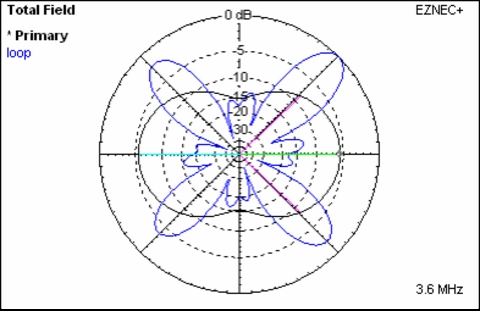
Figure 4: Loop and dipole superimposed
A comparison to simple dipole antenna (figure 4) shows the loop is better by as much as eight db in four very specific narrow directions. The total azimuth area where the loop is equal to or better than the dipole is 125 degrees. On the other hand, the dipole is better than the loop over 235 degrees of azimuth! When located almost anywhere in the mainland USA, we would have far better average signal levels in the USA with a small half-wave dipole antenna.
This leads to a rule we often ignore or forget. If we cannot move the nulls, it is usually better to have a smooth pattern with a bit less gain. The last things we want are multiple nulls in the useful azimuth.
Elevation patterns
What is good for azimuth is also good for elevation. Once again, the last things we want are a plurality of deep nulls scattered throughout useful wave angles. A broader elevation pattern (with no change in efficiency or azimuth coverage) results in slightly less gain, with twice the elevation beamwidth typically reducing gain by 3 dB. This will never be the difference between someone hearing us S9 with one antenna and not hearing us at all with the other. Similarly, a difference in TOA from 30 degrees to 5 degrees will not make that difference either.
The sole exception to this is if we have a pattern with a deep null that happens to fall right at the target angle or direction. The nulls are what cause the problems of significant loss of signal, not gain or TOA!
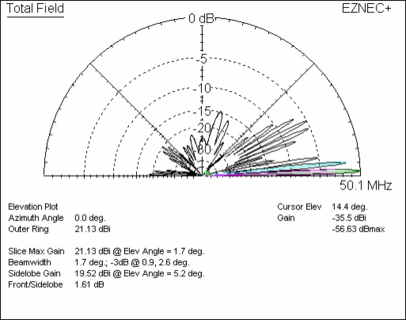
Figure 5: Six-meter stack at W8JI with traditional phasing of high antennas
With this pattern (figure 5), propagation would appear very spotty. A change in wave angle from just 2 degrees to 4 degrees could result in a 20 dB signal reduction. This is not a TOA problem. The problem is rooted in narrow main lobes with deep nulls between sharp peaks. If the signal arrival varied just 1-2 degrees, signal level could go from excellent readability to unreadable.
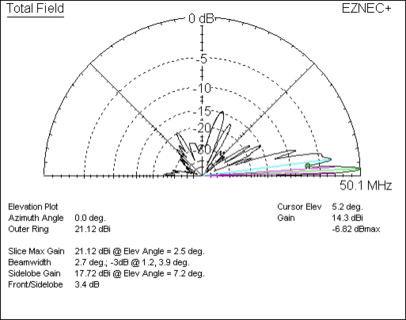
Figure 6:Stack at W8JI, same mean height, with progressive phase lag
One method of correcting the deep nulls is to add antennas and use a progressive phase shift between antennas. Since antennas normally fire in the direction of lagging phase, and since we want to fill nulls above the main lobe, the logical phase shift would be a progressive lagging phase shift with increasingly higher antennas.
In Figure 6, the addition of two more antennas with a lagging 30-degree progressive shift results in an array much less sensitive to wave angle. It has virtually the same field strength, within 6 dB, from 0.9 degrees up to 11 degrees. It still has nearly the same peak gain at very low angles to open the band, or to use when MUF just crosses the operating frequency, yet does not have the problem with 20-30 dB deep nulls if the wave angle shifts as little as 2 to 4 degrees from a lobe peak. Such a pattern would provide much more consistent signals over time.
Other Stacking Mistakes
We make many other stacking mistakes. I almost made one here at my house when I was considering stacking four 20-meter antennas. Fortunately, I put the myths about peak gain and takeoff angle aside and looked carefully at the nulls and beamwidth.
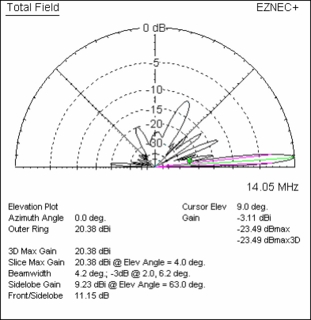
Figure 7: Proposed 20-meter four-antenna stack
My proposed four-antenna stack (figure 7) would have a 23.5 dB null at 9 degrees, which would be right in the hot spot of 20-meter signal a large portion of the time. It also would have less than dipole gain, sometimes significantly less, at any wave angle above 8 degrees. While it is mechanically easier and cheaper to stack multiple antennas one above the other, it is a huge waste of hardware because the pattern is just not that good.
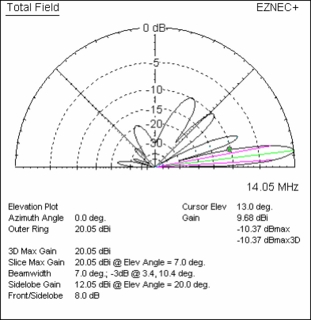
Figure 8: 2X2 H-stack for 20 meters
The antenna in figure 8 is an H arrangement of four antennas. This system uses half of the four-stack tower height, but requires either two towers side-by-side or one tower with two cross supports a full wavelength long. Since the antennas are small (four elements on a 26-foot long boom), I have decided that either arrangement would work.
Notice the peak gain is 20.05 dBi, which is about 11.5 dB over a dipole at optimum height. This system gives under 0.5 dB of peak gain, and gain is useful from well under 2 degrees up to 8 degrees. I have almost doubled the vertical beamwidth, making the antenna far less sensitive to wave angle variations.
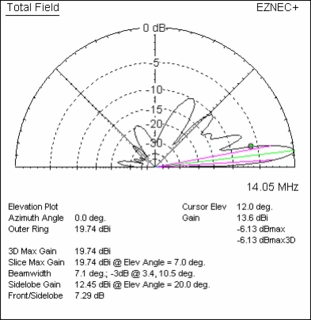
Figure 9: H-stack with upper lagging phase
Lagging phase on upper antennas (figure 9) fills the deep pattern nulls while shifting the main lobe higher. It costs very little gain to do this, peak gain only decreasing 0.3 dB. Field strength is greater than a dipole at optimum height at any angle up to 20 degrees. By switching between these two patterns, this simple system covers most conditions of long distance propagation.
Summary
I hope the article shows why constructive conversation and debate, and looking at things from a different perspective, can lead to better understanding of systems and better antennas. If readers follow my thought processes as I progressed through these various antennas, they should notice I never considered take off angle at all. I looked at gain over the desired angles, focusing especially on nulls and null depth. My goal was maximum signal at all angles within the useful range of angles and directions. Nulls are especially poisonous to our signals. Few will notice a ten or more degree change in peak radiation angle, unless the lobe is very narrow and accompanied by deep nulls a few degrees off peak. If we focus on only one aspect, we can hurt ourselves in the end. We can obtain gain through a very narrow pattern, but if that pattern is full of nulls, we might lose a majority of contacts over time.
Sure, it is nice to brag and say we have 10 dBd gain. It is nice to say we have a low take off angle antenna, or a high angle for local work. Factually, take off angle by itself means nothing. Neither does peak gain. We need to focus on how well a planned antenna works over the most useful angles and directions. We need to pay particular attention to nulls, because the deep nulls, in particular multiple deep nulls, are really what prevents us from hearing and working what would otherwise be spectacular signals.
for those of us who operate dx exclusively the deep nulls at the higher elevation angles are our friends. we have also learned from experience, just as in the case of vhf and uhf antennas at 1, 2 or more wavelengths above ground and understanding that under these conditions the earth ground underneath these small antennas no longer has any effect or influence over the formation and shape of the radiation patterns, so too when elevated radial vertical monopoles operating on 11 meters are elevated at the feedpoint to heights of 5,6,7,8 and 9/4 wavelengths above earth ground and beyond this same scenario plays itself out, the only difference being that 1 wavelength at say 2 meters is a lot shorter than 1 wavelength at 11, the principle is the same. both directivity and maximum gain occur simultaneously at the more desirable, lower elevation angles for long distance communications as the feedpoint height is increased. the deep nulls at the higher elevation angles keep the receiver front end free of strong local signals so the signals arriving from other stations also via low elevation angle longpath take precedence in terms of signal strength. that's what antenna radiation effectiveness is all about, directing your signal where you want it to go while maximizing the strength of signals arriving from the same elevation angles at the receiver front end.
if i should at any time wish to increase coverage into areas at closer proximity i can gradually raise the elevation angle by simply lowering the support structure, more easily accomplished by lowering the tower remotely.
btw, both elevation angle and takeoff angle are just two terms describing the same parameter. i noticed a long time ago that w8ji never uses the second of the two terms when speaking with other licensed amateurs or providing references in amateur publications. i have also noticed that companies marketing and selling antennas like dxantennas.com love to use the latter of the two terms. fascinating.
Last edited:
